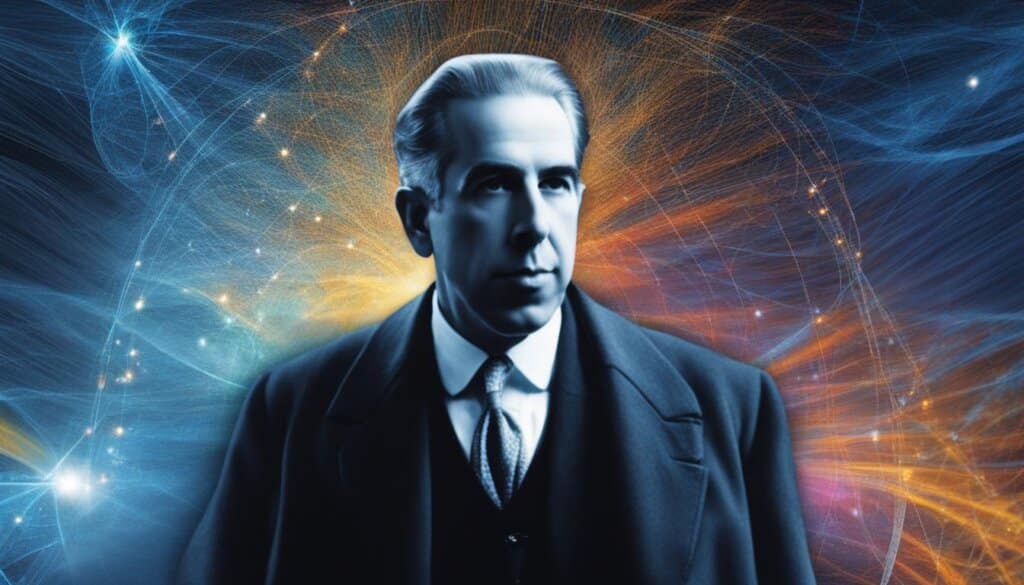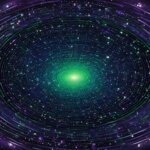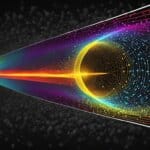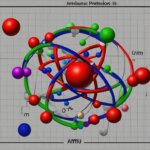Table of Contents
Quantum theory, also known as quantum physics or quantum mechanics, is the theoretical basis of modern physics. It explains the nature and behaviour of matter and energy at the atomic and subatomic level. The development of quantum theory began with Max Planck’s discovery of quanta in 1900, which revolutionised our understanding of energy. Quantum theory has since been supported by numerous experiments and is now the foundation of many fields, including quantum computing, quantum optics, quantum chemistry, and quantum cryptography.
Quantum theory provides insights into the fundamental building blocks of the universe, revealing a realm governed by fascinating principles and phenomena. It unravels the mysteries of matter and energy at the atomic level and offers a powerful framework for our understanding of the physical world. Through the lens of quantum mechanics, scientists delve into the intricate workings of particles, waves, and the intriguing interplay between them.
In this in-depth exploration of quantum theory, we will delve into its key principles and fascinating facts. We will trace the development of the theory, from the pioneering contributions of notable scientists to the present-day applications that continue to shape our world. Join us on this captivating journey through the quantum realm, where matter and energy exist in a dazzling dance of uncertainty and possibilities.
The Development of Quantum Theory
The development of quantum theory involved contributions from several renowned scientists. Max Planck, Albert Einstein, Louis de Broglie, and Werner Heisenberg made significant breakthroughs that led to our modern understanding of this revolutionary field.
“We’ve been forced to think of energy as an associative property of matter — for example, as an attribute of some mechanical system. But what if this association were not fundamental at all, but was merely the consequence of an entirely different property, as yet unknown, of energy itself?” – Max Planck
In 1900, Max Planck introduced the concept of quanta, individual units of energy, in his groundbreaking work on black-body radiation.
“It seems to me that we must give up the notion of a direct contradiction between classical radiation theory and the theory of quanta.” – Albert Einstein
In 1905, Albert Einstein proposed his theory of the photoelectric effect, in which he suggested that energy and radiation are quantized, confirming Planck’s revolutionary ideas.
“In conclusion, we may say that the behavior of energy quanta and waves, as well as that of material particles, is not at all peculiar; rather, it reveals that what we have here is a generality common to all natural phenomena.” – Louis de Broglie
Louis de Broglie’s concept of wave-particle duality, introduced in 1924, further expanded our understanding of quantum theory. He proposed that energy and matter behave as both particles and waves, challenging classical notions of physics.
“The more precisely the position is determined, the less precisely the momentum is known in this instant, and vice versa.” – Werner Heisenberg
Werner Heisenberg’s uncertainty principle, put forth in 1927, established the fundamental limits of measurement in quantum mechanics. It states that the precise simultaneous measurement of two complementary values, such as position and momentum, is impossible.
These groundbreaking contributions, along with others from scientists such as Niels Bohr, Erwin Schrödinger, and Paul Dirac, laid the groundwork for the development of quantum theory. The fusion of these ideas sparked a paradigm shift in the field of physics, challenging long-held beliefs and revolutionizing our perception of the microscopic world.
Key Contributors to Quantum Theory
| Name | Year | Contribution |
|---|---|---|
| Max Planck | 1900 | Introduced the concept of quanta |
| Albert Einstein | 1905 | Proposed the quantization of energy and radiation |
| Louis de Broglie | 1924 | Suggested wave-particle duality of energy and matter |
| Werner Heisenberg | 1927 | Formulated the uncertainty principle |
The Copenhagen Interpretation and the Many-Worlds Theory
Two major interpretations of quantum theory’s implications for the nature of reality are the Copenhagen interpretation and the many-worlds theory. These interpretations, proposed by renowned scientists, offer different perspectives on the fundamental principles of quantum mechanics.
The Copenhagen interpretation, formulated by Niels Bohr, suggests that a particle’s properties are not fixed until they are measured. According to this interpretation, a particle exists in a state of superposition, where it can simultaneously exist in multiple states or locations. It is only when a measurement is made that the particle “collapses” into a single definite state. This interpretation challenges the notion of objective reality and emphasizes the role of observation and measurement in determining the characteristics of quantum systems.
The principle of superposition is a key element of the Copenhagen interpretation. It suggests that particles can exist in multiple states or locations at the same time. This concept is often illustrated through the famous thought experiment of Schrödinger’s cat, which demonstrates a paradoxical scenario where a cat can be simultaneously alive and dead until observed.
“The task of physics is to become a dialogue concerning the projections we ourselves make on nature and to find a correspondence with them by means of the symbols of our theoretical constructions.” – Niels Bohr
On the other hand, the many-worlds theory, proposed by physicist Hugh Everett and popularized by Stephen Hawking, offers an alternative explanation for the behavior of quantum systems. According to this theory, when a quantum object has the potential to exist in multiple states, the universe splits into parallel branches, each representing a different outcome. In these parallel universes, each possibility is realized, creating a “multiverse” that encompasses all possible states and outcomes.
The many-worlds theory posits that every decision or event that could have multiple outcomes generates a divergence of realities, where each possibility becomes a separate universe. This interpretation seeks to preserve the idea of objective reality by suggesting that all possible outcomes actually occur in different branches of the multiverse.
These interpretations have sparked debate and continue to shape our understanding of quantum theory. While the Copenhagen interpretation focuses on the role of measurement and observation, the many-worlds theory presents a multiverse where all possibilities are realized. Both interpretations provide intriguing insights into the nature of reality and challenge our classical understanding of the world.

The Copenhagen Interpretation vs. Many-Worlds Theory: A Comparison
| The Copenhagen Interpretation | The Many-Worlds Theory |
|---|---|
| Proposed by Niels Bohr | Proposed by Hugh Everett |
| Suggests that properties are not fixed until measured | Proposes a multiverse where all possibilities are realized |
| Emphasizes the role of observation and measurement | Preserves the idea of objective reality in a multiverse |
| Focuses on the principle of superposition | Highlights the branching of realities |
Wave-Particle Duality in Quantum Mechanics
One of the fundamental principles of quantum mechanics is wave-particle duality. It describes the phenomenon where quantum objects, such as photons and electrons, exhibit properties of both particles and waves. This concept challenges our classical understanding of matter and energy and provides deep insights into the nature of the quantum realm.
Wave-particle duality can be observed in various phenomena. For instance, when light passes through a prism, it diffracts and demonstrates both wave-like and particle-like behavior. This experiment illustrates that light can exhibit interference patterns characteristic of waves, as well as discrete particles called photons.
However, the most famous demonstration of wave-particle duality comes from the double-slit experiment. In this experiment, a beam of electrons is directed towards a barrier with two slits. Surprisingly, when the electrons pass through the slits and hit a screen, they create an interference pattern similar to that created by waves. This interference pattern can only be explained by the superposition of waves emanating from the two slits. The electrons’ ability to interfere with themselves demonstrates their wave-like nature, reinforcing the concept of wave-particle duality.
The Dual Nature of Matter and Energy
Wave-particle duality extends beyond photons and electrons. It is observed in other particles as well, including protons, neutrons, and even large molecules. This duality highlights the complex nature of the quantum world, where particles can exhibit both localized and extended behavior.
The understanding of wave-particle duality in quantum mechanics has profound implications for our perception of reality at the subatomic level. It suggests that at the quantum scale, particles do not have fixed properties. Instead, they exist in a superposition of states, simultaneously exhibiting particle-like and wave-like characteristics.
“Do not try to understand it, that’s impossible. Instead, only try to realize the truth… There is no spoon. Then you’ll see that it is not the spoon that bends, it is only yourself.”
Wave-particle duality challenges our intuitive understanding of the physical world and underscores the need for a new framework to explain quantum behavior. This principle, along with other fundamental concepts in quantum mechanics, continues to captivate scientists and drive advancements in various fields, from quantum computing to quantum cryptography.
| Key Concepts | Examples |
|---|---|
| Particle-like properties | Mass, charge, momentum |
| Wave-like properties | Interference, diffraction, wavelength |
| Superposition | Simultaneous existence in multiple states |
| Interference | Creation of patterns by overlapping waves |
The Role of Measurement in Quantum Mechanics
In quantum mechanics, the measurement process plays a crucial role in understanding the behavior of particles. When a measurement is taken, the wave function of a particle collapses, causing it to lose its wave-like properties and interference patterns. This collapse of the wave function is a fundamental aspect of quantum mechanics.
The collapse of the wave function occurs because measurement forces the particle to take on a definite value for the quantity being measured. Prior to measurement, the particle exists in a superposition of states, meaning it can be in multiple states simultaneously. However, once measured, the wave function collapses to a single state, eliminating the superposition.
The uncertainty principle, proposed by Heisenberg, adds another layer of complexity to the measurement process. It states that certain pairs of complementary values, such as position and momentum, cannot be precisely measured at the same time. This inherent uncertainty in measurement adds to the probabilistic nature of quantum mechanics and underscores the limitations of our knowledge at the micro level.
One of the intriguing phenomena in quantum mechanics is entanglement. When two particles become entangled, measuring the properties of one particle instantaneously affects the properties of the other particle, regardless of their spatial separation. This phenomenon highlights the interconnectedness of quantum systems and challenges our intuitions about causality.
Examples of Quantum Measurements
Quantum measurements have been conducted in various experiments to confirm the principles of quantum mechanics. One famous example is the double-slit experiment, which demonstrates the wave-particle duality of photons or electrons. When particles are sent through two slits, they create interference patterns on a screen, suggesting wave-like behavior. However, when a measurement is taken to determine which slit the particles pass through, the interference pattern disappears, indicating particle-like behavior.
The Collapse of the Wave Function
The concept of the collapse of the wave function can be better understood through a hypothetical scenario. Imagine a particle in a superposition of being in two different locations. Until a measurement is taken to determine its position, the particle exists in both locations simultaneously. However, once the measurement is made, the wave function collapses, and the particle is found in one specific location.
Uncertainty and Measurement
Heisenberg’s uncertainty principle sets limits on the precision with which certain pairs of physical properties can be measured. For example, the more accurately we measure a particle’s position, the less accurately we can know its momentum, and vice versa. This fundamental uncertainty is inherent to the quantum world and reflects the limitations of measurement in quantum mechanics.
The Intricacies of Entanglement
Entanglement is a phenomenon where two or more particles become correlated in such a way that the state of one particle is connected to the state of another, regardless of the distance between them. When a measurement is made on one entangled particle, the properties of the other entangled particle are instantaneously determined. This instantaneous correlation challenges our classical notions of cause and effect and reveals the intricate nature of entangled systems.
The role of measurement in quantum mechanics is crucial in understanding the behavior of particles. It leads to the collapse of the wave function, introduces uncertainty in measurement, and reveals the entangled nature of quantum systems. By unraveling the mysteries of quantum measurement, scientists continue to uncover the profound and fascinating world of quantum mechanics.
Applications and Influence of Quantum Theory
Quantum theory has revolutionized various scientific fields, leading to significant advancements and practical applications in modern physics. Let’s explore some of the key areas where quantum theory has made a profound impact.
Quantum Optics
Quantum optics focuses on the behavior of light at the quantum level. By studying the interaction between light and matter, quantum optics has paved the way for cutting-edge technologies such as quantum sensors, quantum communication networks, and quantum imaging systems. This branch of quantum physics has enabled us to understand and control the fundamental properties of light, opening up new possibilities for precision measurements and quantum information processing.
Quantum Chemistry
Quantum chemistry applies the principles of quantum mechanics to understand the behavior of atoms and molecules. By solving the Schrödinger equation, quantum chemists can predict the structure, properties, and reactivity of complex chemical systems. This knowledge is invaluable for drug discovery, material science, and the development of sustainable energy technologies. Quantum chemistry enables us to explore chemical processes at a microscopic level and design novel materials with tailored properties.
Quantum Computing
Quantum computing harnesses the unique properties of quantum systems to perform complex computations more efficiently than classical computers. Quantum bits, or qubits, can exist in multiple states simultaneously, allowing quantum computers to handle vast amounts of information in parallel. This revolutionary technology has the potential to solve complex problems in areas such as cryptography, optimization, and simulation. As quantum computing continues to advance, it holds the promise of transforming the fields of finance, logistics, and scientific research.
Quantum Cryptography
Quantum cryptography leverages the principles of quantum mechanics to ensure secure communication. By utilizing the properties of quantum particles, such as entanglement and superposition, quantum cryptography enables the exchange of information with provable security. Quantum key distribution, a key application of quantum cryptography, provides unbreakable encryption keys, protecting sensitive data from eavesdropping attacks. As cybersecurity becomes increasingly critical, quantum cryptography offers a robust solution for safeguarding sensitive information.
Modern Physics
Quantum theory, along with Einstein’s theory of relativity, forms the foundation of modern physics. It provides a unified framework for understanding the fundamental nature of matter, energy, and the universe. From the behavior of subatomic particles to the structure of black holes, modern physics takes us beyond classical theories and challenges our worldview. By embracing the counterintuitive nature of quantum theory, modern physics enables us to unravel the mysteries of the cosmos and explore the frontiers of our existence.
The applications of quantum theory extend far beyond the areas mentioned above. Quantum technologies are advancing rapidly, unlocking new possibilities and reshaping various fields. As our understanding of quantum theory deepens, we can expect further breakthroughs and transformative advancements in the years to come.
| Field | Key Applications |
|---|---|
| Quantum Optics | Quantum sensors, quantum communication networks, quantum imaging systems |
| Quantum Chemistry | Drug discovery, material science, sustainable energy technologies |
| Quantum Computing | Cryptography, optimization, scientific research |
| Quantum Cryptography | Secure communication, quantum key distribution |
| Modern Physics | Understanding matter, energy, and the universe |
Quantum Theory and Experiments
Over the course of the past century, scientists have conducted numerous experiments to test and validate the principles of quantum theory. These experiments have been instrumental in demonstrating various quantum phenomena, providing concrete evidence for the counterintuitive nature of the quantum realm.
One of the most remarkable findings from quantum theory experiments is the phenomenon of entanglement. Scientists have observed that when two particles become entangled, their properties remain interconnected regardless of the distance between them. This baffling phenomenon, famously described as “spooky action at a distance” by Albert Einstein, challenged the notion of local realism and opened up new avenues for exploring quantum communication and computation.
Another intriguing aspect of quantum theory that has been experimentally verified is the principle of superposition. Experiments have shown that particles, such as electrons and photons, can exist in multiple states simultaneously, blending aspects of both particles and waves. This unique feature has paved the way for advances in quantum computing and cryptography, where information can be encoded and processed using quantum bits (qubits) that can exist in multiple states simultaneously.
Quantum theory experiments have consistently provided proof of concepts that drive advancements in quantum technologies, offering a tantalizing glimpse into the potential applications and capabilities of the quantum realm.
The phenomenon of interference, which occurs when quantum particles exhibit wave-like behavior and produce patterns of constructive and destructive interference, has also been extensively studied and validated through experimental observations. The infamous double-slit experiment, where particles are sent through two slits and create an interference pattern on a screen, highlights the wave-particle duality inherent in quantum objects.
Quantum theory experiments continue to push the boundaries of our understanding and inspire further research. They not only confirm the foundational principles of quantum theory but also provide valuable insights into the behavior of matter and energy at the most fundamental level.
As scientists delve deeper into the quantum world through increasingly sophisticated experiments, they uncover new quantum phenomena and unlock the potential for groundbreaking technologies. Quantum theory experiments are imperative for unlocking the full potential of quantum technologies and paving the way for future advancements in various fields, including quantum computing, quantum communication, and quantum sensing.
Exploring the Quantum World
Embarking on a journey to explore the quantum world takes us deep into the realm of fundamental laws that govern particles and forces. Quantum physics, with its enigmatic and perplexing nature, forms the bedrock of the standard model of particle physics and cosmology. The quantum world may appear mysterious and complex, but it holds tremendous potential for innovative technologies and practical applications. By embracing the principles of superposition, measurement, and entanglement, quantum physics allows us to push the boundaries of scientific advancements in various fields, shaping our understanding of the universe.
In the pursuit of quantum physics exploration, scientists delve into the intricate fabric of reality, unearthing the hidden beauty of quantum laws. These laws govern the behavior of microscopic particles, revealing the profound interconnectedness among matter and energy. Insights gained through the exploration of quantum physics have implications not only for cosmology but also for fields such as quantum computing, quantum cryptography, and quantum optics.
Through the lens of cosmology, quantum physics offers a glimpse into the origins and evolution of the universe itself. It sheds light on the intricate dance of particles and forces during the early stages of the cosmic history. By studying the quantum laws that govern the quantum world, scientists strive to unravel the mysteries surrounding the birth and evolution of our cosmos.
FAQ
What is quantum theory?
Quantum theory, also known as quantum physics or quantum mechanics, is the theoretical basis of modern physics. It explains the nature and behavior of matter and energy at the atomic and subatomic level.
Who were the key scientists involved in the development of quantum theory?
The development of quantum theory involved contributions from several scientists, including Max Planck, Albert Einstein, Louis de Broglie, and Werner Heisenberg.
What are the two major interpretations of quantum theory’s implications for the nature of reality?
The two major interpretations are the Copenhagen interpretation and the many-worlds theory.
What is wave-particle duality in quantum mechanics?
Wave-particle duality is the principle that quantum objects exhibit both particle-like and wave-like properties.
How does measurement affect particles in quantum mechanics?
Taking a measurement of a particle collapses its wave function, causing it to no longer exhibit wave-like behavior and interference patterns.
What are the applications and influences of quantum theory?
Quantum theory has had a significant impact on various scientific fields and technological advancements, including quantum optics, quantum chemistry, quantum computing, and quantum cryptography.
What experiments have been conducted to test quantum theory?
Scientists have conducted numerous experiments to test and validate the principles of quantum theory, demonstrating various quantum phenomena such as entanglement, superposition, and interference.
Why is exploring the quantum world important?
Exploring the quantum world allows us to delve into the fundamental laws that govern particles and forces, providing insights into the nature of the universe and driving advancements in various fields.







